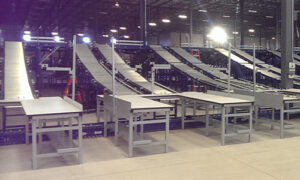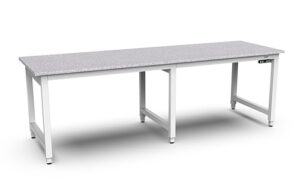In the world of manufacturing one thing is certain, efficiency can make or break a company. A well-designed assembly line is crucial to a company’s productivity and profitability. Central to this concept is the strategic arrangement of workstations along the assembly line. Each workstation plays a pivotal role in the overall workflow, and optimizing this setup can lead to significant gains in efficiency. Let’s explore some tips for setting up an efficient assembly line with workstations:
1. Analyze Workflow
Before setting up the assembly line, it’s essential to thoroughly analyze the workflow. Understand the sequence of tasks involved in the manufacturing process and identify any potential bottlenecks or inefficiencies. This analysis will serve as the foundation for designing an optimize assembly line layout.

U-Shaped workstations were integrated with conveyor systems, allowing workers to receive in parts as well as move them to the next station on this assembly line.
2. Implement Lean Principles
If you haven’t already started following Lean manufacturing processes, now is the time. Lean manufacturing focuses on eliminating waste and maximizing value. Apply Lean principles when setting up your work zones by arranging workstations in a logical sequence that minimizes unnecessary movement and transportation of materials. Additionally, ensure that each workstation is equipped with the tools and resources needed to perform its specific task efficiently.
3. Standardize Workstation Layouts
By standardizing workstation layout across the entire assembly line, you can promote consistency and streamline all operations. Be sure to design each workstation with a clear and intuitive layout, ensuring that employees can easily access materials and tools without wasting time searching or reaching. Consistency in workstation layouts also simplifies training for new employees and facilitates smoother transitions between tasks.
4. Optimize Workstation Ergonomics
Ergonomic design is imperative for the health and safety of assembly line workers. Arrange workstations in such a way to minimize repetitive motions and physical strain, such as bending, reaching, or lifting heavy objects. Invest in ergonomic tools and equipment such as adjustable-height workbenches , and ergonomic seating, to support employee comfort and productivity.

An automate adjustable height workstation, like this in-line version creates an extended work area.
5. Incorporate Automation and AI
Wherever possible, leverage automation technologies, AI and The Internet of Things (IoT) to collect data and streamline repetitive or labor-intensive tasks. Automated systems can significantly improve speed and accuracy of production, while at the same time nearly eliminating the risk of errors and fatigue associated with manual labor. Automated machinery and robotics within the assembly line can handle tasks such as material handling, assembly, and quality control.
6. Quality Control
Quality control is essential to ensure that products meet the highest standards of excellence. Integrate quality checkpoints throughout the assembly line to inspect components and products at different stages of production. By detecting and addressing defects early in the process, you can prevent costly rework or customer returns down the line.
7. Continuously Monitor and Improve
Setting up an efficient assembly line is not a one-time setup, but an ongoing process of continuous improvement. Monitoring key performance metrics such as cycle time, throughput, and defect rates, will help identify areas that can be optimized. Be sure to solicit feedback from frontline employees and encourage a culture of continuous improvement to drive innovation and efficiency across the product assembly line.
In today’s competitive manufacturing landscape, efficiency within an assembly line is a must to stay competitive in the marketplace. By following these tips for creating a streamlined assembly line with workstations, manufacturers can enhance productivity, reduce costs, and deliver high-quality products to the market more quickly. In addition, by prioritizing workflow processes such as lean principles, ergonomic design, automation technologies, and quality control, companies can optimize their assembly line for maximum efficiency.

